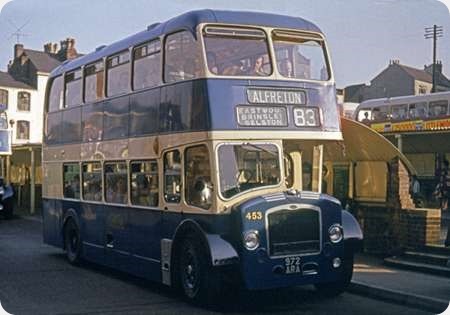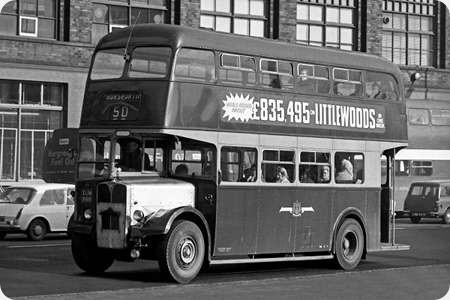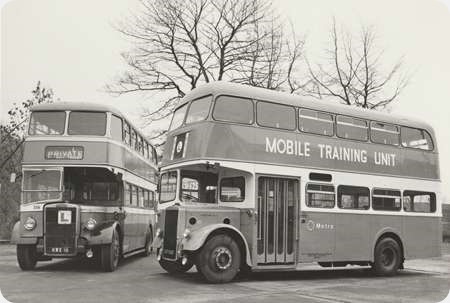
Midland General Omnibus Company
1956
Bristol Lodekka LD6G
ECW H33/25RD
Photographed in Nottingham in August 1961 is Midland General 453, 972 ARA, a Bristol LD6G Lodekka with ECW H33/25RD bodywork, delivered to the operator in October 1956. This vehicle, together with other buses from across the NBC, went to West Riding in April 1970 to expedite the withdrawal of the troublesome Guy Wulfrunian fleet. Sadly, 453 didn’t last very long in the care of West Riding as it went to the scrapyard in December 1971 having, rather pointlessly, been renumbered No. 408 just one month earlier.
Photograph and Copy contributed by Roger Cox
09/04/18 – 07:39
Such a pity the BTC had such a rigid livery policy with most Loddekkas being in wall to wall red or green. We were denied the opportunity to see such attractive vehicles in attractive liveries such as this one on a wider scale. The Midland General livery seemed to slip through the livery police net somehow but the loophole was soon spotted by the dreaded NBC and the even more dreaded poppy red was soon inflicted.
Philip Halstead
10/04/18 – 05:39
I agree – the only other attractive exception was BH&D, who had cream roofs and a much deeper band of crew around the lower deck windows – oh, and I think that either Notts & Derby or Mansfield District did something similar with Tilling Green and cream. Pity as the ECW body was beautifully proportioned, although too Spartan inside for my taste.
David Wragg
10/04/18 – 05:40
Some Midland General vehicles were initially painted dark blue with a white band and the fleetname in NBC style.
Stephen Bloomfield
10/04/18 – 05:41
Midland General never was a Tilling company but throughout it’s existence as a BTC and THC operator, it’s vehicles were always immaculately turned out, regardless of age and always sported comprehensive, fully working blind displays with via points shown, right until the later FLFs and VRs which had provision for ultimate destination and service number only. It was strict company policy that they must be correctly set too, the word ‘SERVICE’ would never have been allowed, in fact it wasn’t even on the blinds as an option.
Chris Barker
11/04/18 – 06:00
What is often overlooked regarding the BTC’s standard red and cream/green and cream ‘Tilling’ liveries is that when they were first introduced, the Tilling Group was in private hands. For many years the Group had operated a policy of centralised control and one of its aims, post-World War II, was to standardise on its ‘in house’ Bristol-ECW products – namely the K type double-decker in highbridge or lowbridge form, and the L type single-decker in bus or express form. Standard liveries for its bus fleets were also being pursued. When the Tilling Group was nationalised in 1948, outwardly it would probably have looked like ‘business as usual’ to the general public, as the old Tilling liveries remained. Interestingly, when the Balfour Beatty Group came under state control, Midland General, Notts & Derby Traction and Mansfield District retained their original liveries. Later, when the Red & White Group was acquired, Cheltenham District continued with its dark red and cream livery, applied in its distinctive fashion. The BTC did not seem to be as obsessed with rigid standardisation as perhaps the privately owned Tilling Group had been.
Although many of the coaches in the BTC fleets donned cream with either green or red/maroon relief, some distinctive and well respected coach liveries continued – those of United, Royal Blue, South Midland, Bristol-Greyhound, and Crosville spring to mind. Presumably prestige and local good will still counted for something, even under state control.
When the THC and BET Group were combined to form the state owned NBC in 1969, with the well-intentioned objective of halting the decline in bus use, for the first few years it appeared once again to be ‘business as usual’ regarding liveries. Ironically, it was someone from the private sector – one Freddie Wood – at the behest of the Heath government, who was responsible for the corporate liveries inflicted on the constituent companies in 1972. The standardised poppy red and white, or leaf green and white liveries for buses and ‘local coaches’ and the allover white National coach livery were not a patch on the liveries they replaced. In fairness, the introduction of the ‘National white coach network’ did improve public awareness of express travel and business did increase as a result, but why such an impractical colour was chosen for such hard working vehicles operating over long distances in all weathers remains a mystery.
Brendan Smith
11/04/18 – 06:04
Midland General, together with Notts & Derby and Mansfield District, were Balfour Beatty companies. Balfour Beatty initially concentrated upon tramway operation in Nottinghamshire and Derbyshire, whence it then broadened its activities into electricity generation and supply in those counties. When the electricity supply industry was nationalised in 1948, that aspect of the Balfour Beatty operation was taken over by the government, but the three public transport components of the business, by then using trolleybuses and motor buses, did not automatically follow suit. The disposal of Midland General, Mansfield District and Notts & Derby was a decision taken by Balfour Beatty in the light of the then Labour government’s aspirations for public ownership of the bus industry. Tilling sold out at about the same time, but the BET resisted. I agree with Chris that the standards of Midland General were very high, endorsed by the splendid livery.
Roger Cox
19/04/18 – 06:35
The reason that the Midland General fleet could be so smart was that the services operated were extremely profitable compared with other operators such as Trent.
Nigel Turner
20/04/18 – 06:40
Indeed so Nigel, Midland General had some very lucrative routes and on weekdays they operated many works and colliery services which operated throughout the day to meet changing shift patterns. On Saturdays, when vehicles which had been used on such duties might otherwise have stood idle, many of their principal services were so busy with shoppers, they were doubled in frequency, so the fleet was fully utilised. A blue livery and a blue chip company!
Chris Barker
23/05/18 – 06:47
Roger, the shareholdings of MGOC/NDT/MDT were all held by the Balfour Beatty subsidiary "MIDESCO", the Midland Counties Electricity Supply Company – it was MIDESCO which was nationalised as part of the compulsory nationalisation of the electricity supply industry, becoming part of the British Electricity Authority (BEA). It was because Balfour Beatty chose not to separate out the accounts for MGOC/NDT/MDT from those of the parent (MIDESCO) that they were nationalised (as part of that electricity supply company). Initially the BEA negotiated with a management agreement with Balfour Beatty for "oversight" of MGOC/NDT/MDT, but this lasted only months until the BEA transferred MGOC/NDT/MDT to the BTC.
The Llanelly & District company ended up in state-owned hands for similar reasons, but the outcome then was quite different.
Philip Rushworth
24/05/18 – 07:29
Thanks for that clarification, Philip. An interesting website about the Midland General Group may be found here:- https://midlandgeneralomnibus.weebly.com
Roger Cox
31/08/20 – 06:21
The location of the photo is the old Mount St bus station in Nottingham, a place I was most familiar with, since I lived in Nottingham until 1964, and my bus home (either the Nottingham City Transport 63 or more usually the Midland General F5) left from there. It was a pretty basic facility, and I understand it was actually a genuine wartime utility bus station! Presumably the utility Guy Arabs in the Midland General and Barton fleets, which in the early 1960s were regulars there, felt at home in the place. I believe the place was built to ease overcrowding at Nottingham’s original Huntingdon St bus station, and would also save a bit of mileage for routes from the west,, probably an important consideration during the war. I always found the Midland General buses to be well presented and reliable, but it always seemed strange to me that travelling to and from school on the F5, usually on the same departures each day, you never knew what vehicle would turn up – anything from a utility Guy to a brand new Lodekka. The route was worked by Ilkeston Depot, and they seemed to have no consistency as to what was sent out on what duty. Mount St was replaced by a new smaller facility nearby after I left Nottingham, but that had a fairly short life before closure.
Chris Appleby



